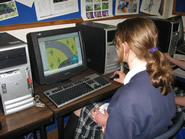Simplifying NCEA Assessment

Cluster members all agreed that assessment processes were tending to drive the teaching programme and thus inhibiting student learning and achievement. Assessment schedules and documentation methods used by senior students reduced time for ICT skill development, and the quality of the final outcomes suffered. It was felt that alternative ways of assessment should be explored for internal assessment, including the recording of evidence in a manner more natural to the ICT environment.
Classroom visits by Cliff Harwood and Hugh Derham challenged the teachers to adopt more of an 'assess to learn' approach - by merging assessment into the teaching process, student learning could be enhanced rather than hindered. Cluster members altered their programmes to make them more project- and less assessment-driven. Changes were made to both how and when assessment was structured into the NCEA programmes.
Developing new assessment schedules
In consultation with Cliff and Hugh, alternative assessment schedules were developed for the Level 1, 2, and 3 internally assessed achievement standards. In these schedules, assessment is ongoing, with defined checkpoints structured throughout a project rather than at completion, enabling better monitoring of student progress and earlier intervention where required. "If you pick up on the fact early on in the project that, for example, a student doesn't have a suitable range of stakeholders, you can suggest ways forward so they end up with a better project," says Malcolm.
The main innovation in the new schedules was their transparency - they were simpler and presented in teacher- and student-friendly language. They broadened the range of assessable methods of documentation, with the inclusion of the statement: "The student may demonstrate knowledge and understanding by either physically showing, verbally explaining, writing, sketching and drawing or submitting electronic evidence as appropriate to the assessment situation. The student evidence for assessment may be provided in any order and at any stage during the student's technological practice to develop a technological solution to address a given brief." A column was also included where teachers could provide supporting evidence of a judgement where the evidence is not included in the submitted material, such as when it was given verbally during a discussion. This is important for moderation purposes. These simpler, clearer and more complete assessment schedules not only ensured a more accurate assessment of the student, but also helped ensure uniformity of assessment within and across the schools. Over time they would enable more effective monitoring and tracking of student learning, giving teachers a more complete understanding of an individual student's development.
The new schedules were thoroughly tested in 2006 by applying them retrospectively to student work, and are being fully implemented in 2007.
Developing new ways of presenting evidence
Hugh Derham:
"[When] you're talking about ICT - Information and Communications Technologies - a lot of that information and communication is visual. So why, when you're talking about visual communication, do you make people read and write? There's nothing fundamentally wrong with other assessment from NZQA's perspective - it's only teachers who have put a restriction on the way that they assess."
To streamline assessment the teachers experimented with ways of replacing paper-based documentation with digital, where this was easier and appropriate. By nature, ICT lends itself to a variety of ways of collecting evidence for assessment, such as using video and audio clips, PowerPoint presentations and screen dumps, and saving 'versions' at milestones when programming. All cluster members experimented with these as all levels.
At senior level, the cluster was keen to move away from "large clear-files full of paper", and to see ICT skills put to good use in the collection of evidence of achievement. "The visual diary is a great tool for presenting evidence about creativity and developing a conceptual design," says Malcolm, " but there are many computer tools that are also appropriate for presenting evidence of practice - software that can also enhance student practice. Why use a hand-drawn Gantt chart in a visual diary, for example, when an Excel spreadsheet gives a much more professional look."
Examples of innovative ways of documentation can be seen in the related case studies. This is particularly evident in Malcolm's Year 12 class, where students presented evidence using a wide range of media, including Excel, PowerPoint presentations, various image and graphics files including OmniGraffle Drawing files, and video files - see BP630: Delivery. Of special note is John's use of videos to document a stakeholder and student peers reviewing his final prototype. Videos were also used as documentation in Jenny's Year 11 class - see Zach's video clips (BP629), in which he explains how he designed his Algebra program 'Mystery'
Classroom outcomes in 2006
For Jenny's Year 11 class (Case Study BP629: ICT Programming), students were 'disengaged' from a focus on assessment by focussing on a "real problem for a real-life situation" and the aim to satisfy the needs of stakeholders and a client. Learning involved identifying, learning and using whatever software application was appropriate to their particular need. Achievement of Unit and Assessment Standards naturally accrued over the course of the project and assessment criteria picked out as appropriate, as outlined in the course's Assessment Requirements pdf (296kb).
In Malcolm's Year 12 class (Case Study BP630: Multimedia CD-ROMs), the year began with an introduction to the process of identifying an issue, developing a brief and modelling a conceptual design, and then developing and implementing the solution. Discussion of the specific assessment criteria was delayed until it was necessary. Meeting the assessment criteria became a natural result of good technological practice and ICT skill and knowledge development rather than an ends in itself.
